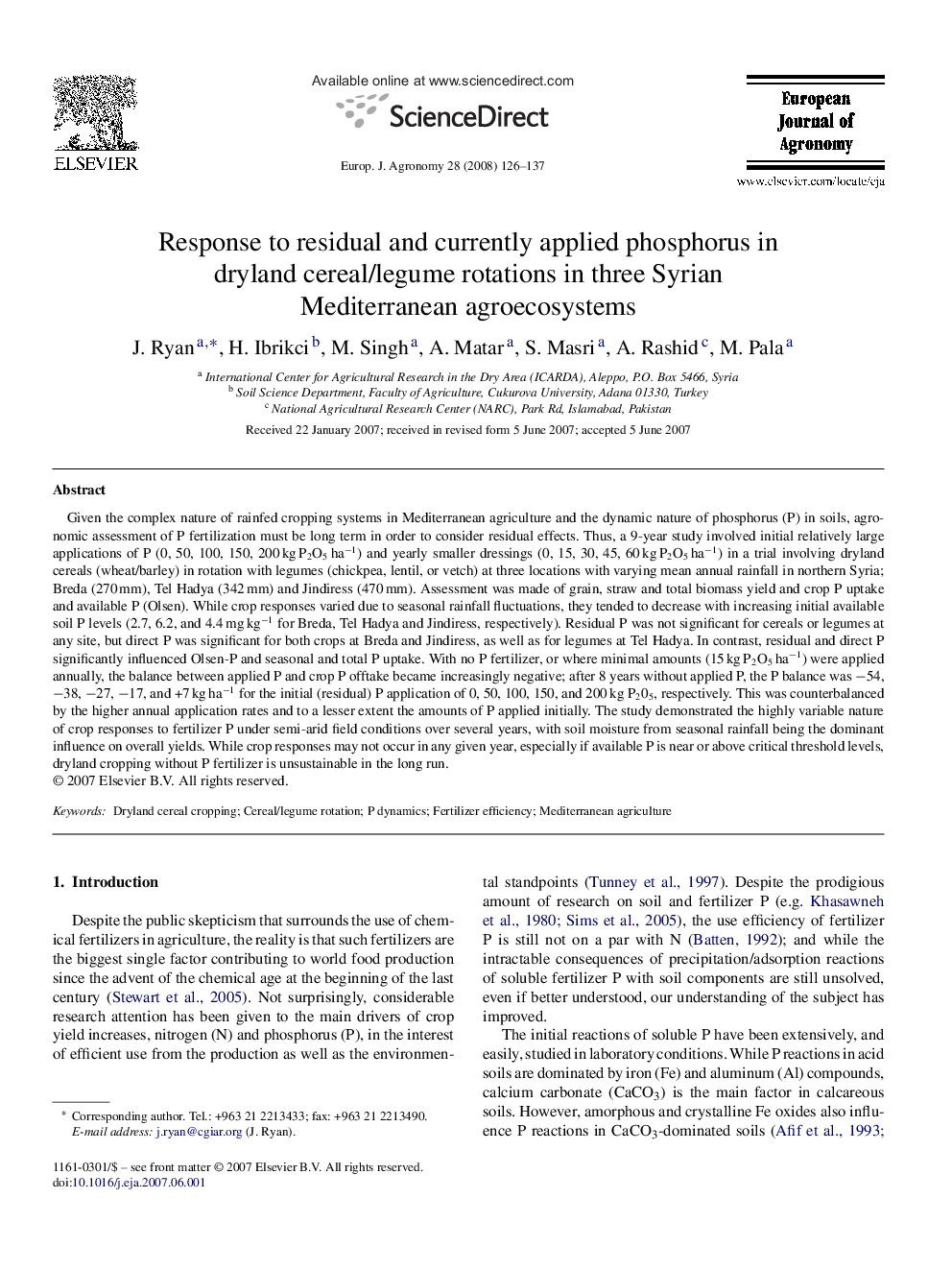| کد مقاله | کد نشریه | سال انتشار | مقاله انگلیسی | نسخه تمام متن |
|---|---|---|---|---|
| 4509524 | 1624520 | 2008 | 12 صفحه PDF | دانلود رایگان |
عنوان انگلیسی مقاله ISI
Response to residual and currently applied phosphorus in dryland cereal/legume rotations in three Syrian Mediterranean agroecosystems
دانلود مقاله + سفارش ترجمه
دانلود مقاله ISI انگلیسی
رایگان برای ایرانیان
کلمات کلیدی
موضوعات مرتبط
علوم زیستی و بیوفناوری
علوم کشاورزی و بیولوژیک
علوم زراعت و اصلاح نباتات
پیش نمایش صفحه اول مقاله

چکیده انگلیسی
Given the complex nature of rainfed cropping systems in Mediterranean agriculture and the dynamic nature of phosphorus (P) in soils, agronomic assessment of P fertilization must be long term in order to consider residual effects. Thus, a 9-year study involved initial relatively large applications of P (0, 50, 100, 150, 200 kg P2O5 haâ1) and yearly smaller dressings (0, 15, 30, 45, 60 kg P2O5 haâ1) in a trial involving dryland cereals (wheat/barley) in rotation with legumes (chickpea, lentil, or vetch) at three locations with varying mean annual rainfall in northern Syria; Breda (270 mm), Tel Hadya (342 mm) and Jindiress (470 mm). Assessment was made of grain, straw and total biomass yield and crop P uptake and available P (Olsen). While crop responses varied due to seasonal rainfall fluctuations, they tended to decrease with increasing initial available soil P levels (2.7, 6.2, and 4.4 mg kgâ1 for Breda, Tel Hadya and Jindiress, respectively). Residual P was not significant for cereals or legumes at any site, but direct P was significant for both crops at Breda and Jindiress, as well as for legumes at Tel Hadya. In contrast, residual and direct P significantly influenced Olsen-P and seasonal and total P uptake. With no P fertilizer, or where minimal amounts (15 kg P2O5 haâ1) were applied annually, the balance between applied P and crop P offtake became increasingly negative; after 8 years without applied P, the P balance was â54, â38, â27, â17, and +7 kg haâ1 for the initial (residual) P application of 0, 50, 100, 150, and 200 kg P205, respectively. This was counterbalanced by the higher annual application rates and to a lesser extent the amounts of P applied initially. The study demonstrated the highly variable nature of crop responses to fertilizer P under semi-arid field conditions over several years, with soil moisture from seasonal rainfall being the dominant influence on overall yields. While crop responses may not occur in any given year, especially if available P is near or above critical threshold levels, dryland cropping without P fertilizer is unsustainable in the long run.
ناشر
Database: Elsevier - ScienceDirect (ساینس دایرکت)
Journal: European Journal of Agronomy - Volume 28, Issue 2, February 2008, Pages 126-137
Journal: European Journal of Agronomy - Volume 28, Issue 2, February 2008, Pages 126-137
نویسندگان
J. Ryan, H. Ibrikci, M. Singh, A. Matar, S. Masri, A. Rashid, M. Pala,